Durability of the Exterior Transparent Coatings on Nano-Photostabilized English Oak Wood and Possibility of Its Prediction before Artificial Accelerated Weathering
Abstract
:1. Introduction
2. Material and Methods
2.1. Wood Samples
2.2. Surface Modification and Coatings
2.3. Artificial Weathering
2.4. Analyses of Tested Wooden Surfaces
2.5. Microscopic and Elemental Composition Analyses, Visual Analyses
2.6. Statistical Evaluation
3. Results and Discussion
3.1. Surface Characteristics of Wood after Modification
3.2. Changes in Color and Gloss during AW
3.3. Changes in Water Contact Angle during AW
3.4. SEM and Visual Analyses
3.5. Final Discussion
4. Conclusions
Author Contributions
Funding
Conflicts of Interest
References
- De Meier, M.; Militz, H. Wet adhesion of low-VOC Coatings on wood. A quantitative analysis. Prog. Org. Coat. 2000, 38, 223–240. [Google Scholar] [CrossRef]
- Ozdemir, T.; Hiziroglu, S. Evaluation of surface quality and adhesion strength of treated solid wood. J. Mater. Proces. Technol. 2007, 186, 311–314. [Google Scholar] [CrossRef]
- Herrera, R.; Sandak, J.; Robles, E.; Krystofiak, T.; Labidi, J. Weathering resistance of thermally modified wood finished with coatings of diverse formulations. Prog. Org. Coat. 2018, 119, 145–154. [Google Scholar] [CrossRef]
- Ahola, P. Adhesion between paints and wooden substrates: Effects on pre-treatment and weathering of wood. Mater. Struct. 1995, 28, 350–356. [Google Scholar] [CrossRef]
- Vitosyté, J.; Ukvalbergiené, K.; Keturakis, G. The effect of surface roughness on adhesion strength of coated ash (Fraxinus excelsior L.) and birch (Betula L.) wood. Mater. Sci. 2012, 4, 347–351. [Google Scholar] [CrossRef]
- De Meier, M. A Review of Interfacial Aspects in Wood Coatings: Wetting, Surface Energy, Substrate Penetration and Adhesion. COST E18 Final Seminar 2005. 16pp. Available online: https://www.researchgate.net/publication/260601859 (accessed on 9 March 2014).
- Cogulet, A.; Blanchet, P.; Landry, V. The multifactorial aspect of wood weathering: A review based on a holistic approach of wood degradation protected by clear coating. BioResources 2018, 13, 2116–2138. [Google Scholar] [CrossRef]
- Gobakken, L.R.; Høibø, O.A.; Solheim, H. Mould growth on paints with different surface structures when applied to wooden claddings exposed outdoors. Int. Biodeterior. Biodegrad. 2010, 64, 339–345. [Google Scholar] [CrossRef]
- Gaylarde, C.C.; Morton, L.H.G.; Loh, K.; Shirakawa, M.A. Biodeterioration of extrenal architectural paint films—A review. Int. Biodeterior. Biodegrad. 2011, 65, 1189–1198. [Google Scholar] [CrossRef]
- Reinprecht, L.; Pánek, M. Effects of wood roughness, light pigments, and water repellent on the color stability of painted spruce subjected to natural and accelerated weathering. BioResources 2015, 10, 7203–7219. [Google Scholar] [CrossRef]
- Evans, P.D.; Haase, J.G.; Shakri, A.; Seman, B.M.; Kiguchi, M. The search for durable exterior clear coatings for wood. Coatings 2015, 5, 830–864. [Google Scholar] [CrossRef]
- Ikei, H.; Song, C.; Miyazaki, Y. Physiological effects of wood on humans: A review. J. Wood Sci. 2017, 63, 1–23. [Google Scholar] [CrossRef]
- George, B.; Suttie, E.; Merlin, A.; Deglise, X. Photodegradation and photostabilisation of wood—The state of the art. Polym. Degrad. Stab. 2005, 88, 268–274. [Google Scholar] [CrossRef]
- Nair, S.; Giridhar, B.N.; Pandey, K.K. UV stabilization of wood by nano metal oxides dispersed in propylene glycol. J. Photochem. Photobiol. B Biol. 2018, 183, 1–10. [Google Scholar] [CrossRef] [PubMed]
- Aloui, F.; Ahajji, A.; Irmouli, Y.; George, B.; Charrier, B.; Merlin, A. Inorganic UV absorbers for the photostabilisation of wood-clearcoating systems: Comparison with organic UV absorbers. Appl. Surf. Sci. 2007, 253, 3737–3745. [Google Scholar] [CrossRef]
- Forsthuber, B.; Grüll, G. The effects of HALS in the prevention of photodegradation of acrylic clear topcoats and wooden surfaces. Polym. Degrad. Stab. 2010, 95, 746–755. [Google Scholar] [CrossRef]
- Saha, S.; Kocaefe, D.; Boluk, Y.; Pichette, A. Surface degradation of CeO2 stabilized acrylic polyurethane coated thermally treated jack pine during accelerated weathering. Appl. Surf. Sci. 2013, 276, 86–94. [Google Scholar] [CrossRef]
- Forsthuber, B.; Schaller, C.; Grüll, G. Evaluation of the photo stabilising efficiency of clear coatings comprising organic UV absorbers and mineral UV screeners on wood surfaces. Wood Sci. Technol. 2013, 2, 281–297. [Google Scholar] [CrossRef]
- Pánek, M.; Reinprecht, L. Effect of the number of UV-protective coats on the color stability and surface defects of painted black locust and Norway spruce woods subjected to natural weathering. BioResources 2016, 11, 4663–4676. [Google Scholar] [CrossRef]
- Pánek, M.; Dvořák, O.; Oberhofnerová, E.; Šimůnková, K.; Zeidler, A. Effectiveness of two different hydrophobic topcoats for increasing of durability of exterior coating systems on oak wood. Coatings 2019, 9, 280. [Google Scholar] [CrossRef]
- Guo, H.; Michen, B.; Burgert, I. Real test-bed studies at the ETH House of Natural Resources-wood surface protection for outdoor applications. Inf. De La Construcción 2017, 69, 9. [Google Scholar] [CrossRef]
- Yu, Y.; Jiang, Z.H.; Wang, G.; Song, Y. Growth of ZnO nanofilms on wood with improved photostability. Holzforschung 2010, 64, 385–390. [Google Scholar] [CrossRef]
- Wang, X.; Liu, S.; Chang, H.; Liu, J. Sol-gel deposition of TiO2 nanocoatings on wood surfaces with enhanced hydrophobicity and photostability. Wood Fiber Sci. 2014, 46, 109–117. [Google Scholar]
- Cataldi, A.; Corcione, C.E.; Frigione, M.; Pegoretti, A. Photocurable resin/microcrystalline cellulose composites for wood protection: Physical-mechanical characterization. Prog. Org. Coat. 2016, 99, 230–239. [Google Scholar] [CrossRef]
- Bulian, F.; Graystone, J. Wood Coatings-Theory and Practice; Elsevier Science: Amsterdam, The Netherlands, 2009; p. 320. ISBN 978-0444528407. [Google Scholar]
- Pizzi, A.; Mittal, K.L. Wood Adhesives Hardcover, 1st ed.; CRC Press: Boca Raton, FL, USA, 2011; p. 462. ISBN 978-9004190931. [Google Scholar]
- Kúdela, J. Wetting of wood surface by a liquids of a different polarity. Wood Res. 2014, 59, 11–24. [Google Scholar]
- Petrič, M.; Oven, P. Determination of wettability of wood and its significance in wood science and technology: A Critical Review. Rev. Adhes. Adhes. 2015, 3, 2–121. [Google Scholar] [CrossRef]
- Wang, X.; Wang, F.; Yu, Z.; Zhang, Y.; Qi, C.; Du, L. Surface free energy and dynamic wettability of wood simultaneously treated with acidic dye and flame retardant. J. Wood. Sci. 2017, 63, 271–280. [Google Scholar] [CrossRef] [Green Version]
- Ziglio, A.C.; Sardela, M.R.; Goncalves, D. Wettability, surface free energy and cellulose crystallinity for pine wood (Pinus sp.) modified with chili pepper extracts as natural preservatives. Cellulose 2018, 25, 6151–6160. [Google Scholar] [CrossRef]
- Kalnins, M.A.; Feist, W.C. Increase in wettability of wood with weathering. For. Prod. J. 1993, 43, 55–57. [Google Scholar]
- Evans, P.D.; Owen, N.L.; Schmid, S.; Webster, R.D. Weathering and photostability of benzoylated wood. Polym. Degrad. Stab. 2002, 76, 291–303. [Google Scholar] [CrossRef]
- Pandey, K.K. A note on the influence of extractives on the photo-discoloration and photo-degradation of wood. Polym. Degrad. Stab. 2005, 87, 375–379. [Google Scholar] [CrossRef]
- Volkmer, T.; Noël, M.; Arnold, M.; Strautmann, J. Analysis of lignin degradation on wood surfaces to create a UV-protecting cellulose rich layer. Int. Wood Prod. J. 2016, 7, 156–164. [Google Scholar] [CrossRef]
- Croituru, C.; Spirchez, C.; Lunguleasa, A.; Cristea, D.; Roata, I.C.; Pop, M.A.; Bedo, T.; Stanciu, E.M.; Pascu, A. Surface properties of thermally treated composite wood panels. Appl. Surf. Sci. 2017, 438, 114–123. [Google Scholar] [CrossRef]
- Lin, Y.; Junhui, H. Recent progress in antireflection and self-cleaning technology-From surface engineering to functional surfaces. Prog. Mater. Sci. 2014, 61, 94–143. [Google Scholar]
- Pánek, M.; Oberhofnerová, E.; Hýsek, Š.; Šedivka, P.; Zeidler, A. Colour stabilization of oak, spruce, larch and Douglas fir heartwood treated with mixtures of nanoparticles dispersions and UV-stabilizers after exposure to UV and VIS-radiation. Materials 2018, 11, 1653. [Google Scholar] [CrossRef] [PubMed]
- Salla, J.; Pandey, K.K.; Srinivas, K. Improvement of UV resistance of wood surfaces by using ZnO nanoparticles. Polym. Degrad. Stab. 2012, 97, 592–596. [Google Scholar] [CrossRef]
- Wagenführ, R. Holzatlas; Fachbuchverlag: Leipzig, Germany, 2007; p. 816. ISBN 3446406492. [Google Scholar]
- Evans, P.D.; Vollmer, S.; Kim, J.D.W.; Chan, G.; Gibson, S.K. Improving the performance of clear coatings on wood through the aggregation of marginal gains. Coatings 2016, 6, 66. [Google Scholar] [CrossRef]
- Sivrikaya, H.; Hafizoglu, H.; Yasav, A.; Aydemir, D. Natural weathering of oak (Quercus petrae) and chestnut (Castanea sativa) coated with various finishes. Color Res. Appl. 2011, 36, 72–78. [Google Scholar] [CrossRef]
- Crewdson, M.J.; Ketola, W.D. Best practices in weathering: Outdoor and accelerated testing compared. Eur. Coat. J. 2009, 4, 116–121. [Google Scholar]
- Grüll, G.; Tscherne, F.; Spitaler, I.; Forsthuber, B. Comparison of wood coating durability in natural weathering and artificial weathering using fluorescent UV-lamps and water. Eur. J. Wood Prod. 2014, 72, 367–376. [Google Scholar] [CrossRef]
- Pánek, M.; Reinprecht, L. Critical view on the possibility of colour changes prediction in the surfaces of painted wood exposed outdoor using accelerated weathering in Xenotest. J. Coat. Technol. Res. 2019, 16, 339–352. [Google Scholar] [CrossRef]
- Cogulet, A.; Blanchet, P.; Landry, V. Evaluation of the impacts of four weathering methods on two acrylic paints: Showcasing distinctions and particularities. Coatings 2019, 9, 121. [Google Scholar] [CrossRef]
- EN 927-6:2006 Paints and Varnishes. Part 6: Exposure of Wood Coatings to Artificial Weathering Using Fluorescent UV Lamps and Water. In Coating Materials and Coating Systems for Exterior Wood; European Committee for Standardization: Brussels, Belgium, 2006.
- Stearns, E.I. Colorimetry, 2nd ed.; Commission Internationale de l’Eclairage: Vienna, Austria, 1986; p. 74. [Google Scholar]
- EN ISO 2813:2015. In Paints and Varnishes, Determination of Gloss Value at 20°, 60° and 85°; European Committee for Standardization: Brussels, Belgium, 2015.
- Wålinder, M.; Johansson, I. Measurement of Wood Wettability by the Wilhelmy Method. Part 1. Contamination of Probe Liquids by Extractives. Holzforschung 2001, 55, 21–32. [Google Scholar] [CrossRef]
- Bastani, A.; Adamopoulos, S.; Militz, H. Water uptake and wetting behaviour of furfurylated, N-methylol melamine modified and heat-treated wood. Eur. J. Wood Wood Prod. 2015, 73, 627–634. [Google Scholar] [CrossRef]
- Gonzalez de Cademartori, P.H.; Missio, A.L.; Dufau Mattos, B.; Gatto, D.A. Natural weathering performance of three fast-growing Eucalypt woods. Maderas-Cienc. Y Tecnol. 2015, 17, 799–808. [Google Scholar] [CrossRef]
- EN ISO 4287:1997. In Geometrical Product Specifications (GPS). Surface Texture. Profile Method. Terms, Definitions and Surface Texture Parameters; International Organization for Standardization: Geneva, Switzerland, 1997.
- EN ISO 4288:1996. In Geometrical Product Specifications (GPS). Surface Texture. Profile Method. Rules and Procedures for the Assessment of Surface Texture; International Organization for Standardization: Geneva, Switzerland, 1996.
- Evans, P.D.; Cullis, I.; Kim, J.D.W.; Leung, L.H.; Hazneza, S.; Heady, R.D. Microstructure and mechanism of grain raising in wood. Coatings 2017, 7, 135. [Google Scholar] [CrossRef]
- Jaić, M.; Palija, T.; Dordević, M. The Impact of Surface Preparation of Wood on the Adhesion of Certain Types of Coatings. Zastita Mater. J. Interv. Cardiol. 2014, 55, 163–169. Available online: http://idk.org.rs/wp-content/uploads/2015/01/2-2014/Jaic%20rad.pdf (accessed on 16 January 2015).
- Eder, M.; Amini, S.; Fratzl, P. Biological composites-complex structures for functional diversity. Science 2018, 362, 543–547. [Google Scholar] [CrossRef]
- Ghosh, M.; Gupta, S.; Kumar, V.S.K. Studies on the loss of gloss of shellac and polyurethane finishes exposed to UV. Maderas Cienc. Tecnol. 2015, 17, 39–44. [Google Scholar] [CrossRef]
- Grüll, G.; Forsthuber, B.; Ecker, M. Sensitivity of waterborne coatings to high acidity and content of arabinogalactan in larch heartwood. Prog. Org. Coat. 2016, 101, 367–378. [Google Scholar] [CrossRef]
- Pánek, M.; Oberhofnerová, E.; Zeidler, A.; Šedivka, P. Efficacy of hydrophobic coatings in protecting oak wood surfaces during accelerated weathering. Coatings 2017, 7, 172. [Google Scholar] [CrossRef]
- De Windt, I.; Van den Bulcke, J.; Wuijtens, I.; Coppens, H.; Van Acker, J. Outdoor weathering performance parameters of exterior wood coating systems on tropical hardwood substrates. Eur. J. Wood Wood Prod. 2014, 72, 261–272. [Google Scholar] [CrossRef] [Green Version]
- Oberhofnerová, E.; Pánek, M.; Böhm, M. Effect of surface pretreatment with natural essential oils on the weathering performance of spruce wood. BioResources 2018, 13, 7053–7070. [Google Scholar]
- Oberhofnerová, E.; Pánek, M. Surface wetting of selected wood species by water during initial stages of weathering. Wood Res. 2016, 61, 545–552. [Google Scholar]
- Žlahtič, M.; Humar, M. Influence of artificial and natural weathering on the hydrophobicity and surface properties of wood. BioResources 2016, 11, 4964–4989. [Google Scholar] [CrossRef]
- Pánek, M.; Reinprecht, L. Color stability and surface defects of naturally aged wood treated with transparent paints for exterior constructions. Wood Res. 2014, 59, 421–430. [Google Scholar]
- Moya, R.; Rodríguez-Zuniga, A.; Vega-Baudrit, J.; Puente-Urbina, A. Effects of adding TiO2 nanoparticles to a water-based varnish for wood applied to nine tropical woods of Costa Rica exposed to natural and accelerated weathering. J. Coat. Technol. Res. 2016, 14, 141–152. [Google Scholar] [CrossRef]
- Tu, K.; Wang, X.; Kong, L.; Guan, H. Facile preparation of mechanically durable, self-healing and multifunctional superhydrophobic surfaces on solid wood. Mater. Des. 2018, 140, 30–36. [Google Scholar] [CrossRef]
- Dawson, B.S.W.; Singh, A.P.; Kroese, H.W.; Schwitzer, M.A.; Gallagher, S. Enhancing exterior performance of clear coatings through photostabilization of wood. Part 2: Coating and weathering performance. J. Coat. Technol. Res. 2008, 5, 207–219. [Google Scholar] [CrossRef]
- Zahri, S.; Belloncle, C.; Charrier, F.; Pardon, P.; Quideau, S.; Charrier, B. UV light impact on ellagitannins and wood surface colour of European oak (Quercus petraea and Quercus robur). Appl. Surf. Sci. 2007, 253, 4985–4989. [Google Scholar] [CrossRef]
- De Meijer, M.; Creemers, J.; Cobben, W. Relationships between the performance of low-VOC wood coatings and the dimensional changes of the wooden substrate. Surf. Coat. Int. Pt. B C 2001, 84, 77–85. [Google Scholar] [CrossRef]
- Cristea, M.V.; Riedl, B.; Blanchet, P. Enhancing the performance of exterior waterborne coatings for wood by inorganic nanosized UV absorbers. Prog. Org. Coat. 2010, 69, 432–441. [Google Scholar] [CrossRef]
- Papadopoulos, A.N.; Bikiaris, D.N.; Mitropoulos, A.C.; Kyzas, G.Z. Nanomaterials and chemical modifications for enhanced key wood properties: A review. Nanomaterials 2019, 9, 607. [Google Scholar] [CrossRef] [PubMed]
- Rao, F.; Zhang, Y.; Bao, M.; Zhang, Z.; Bao, Y.; Li, N.; Chen, Y.; Yu, W. Photostabilizing efficiency of acrylic-based bamboo exterior Coatings combining benzotriazole and zinc oxide nanoparticles. Coatings 2019, 9, 533. [Google Scholar] [CrossRef]
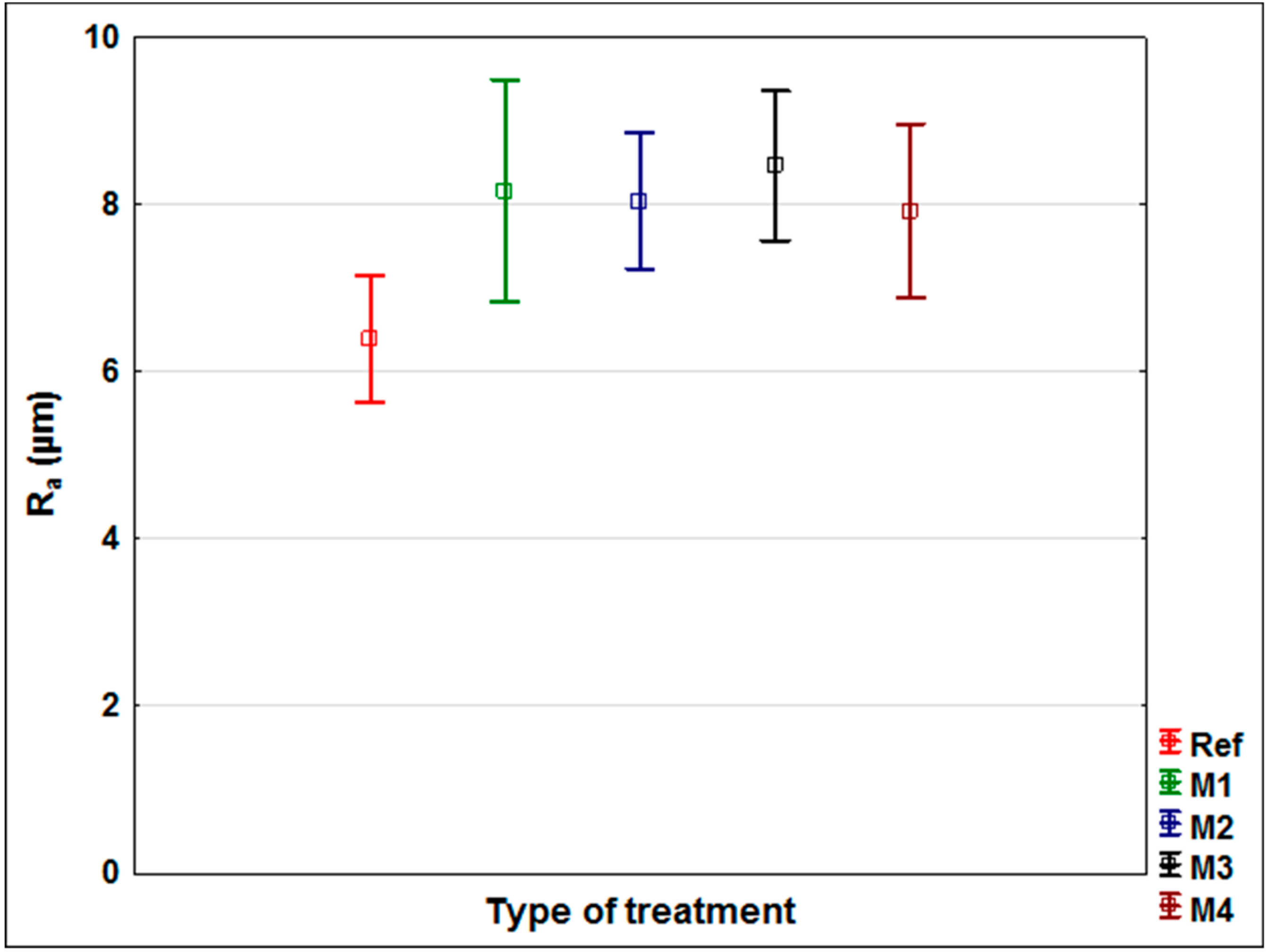
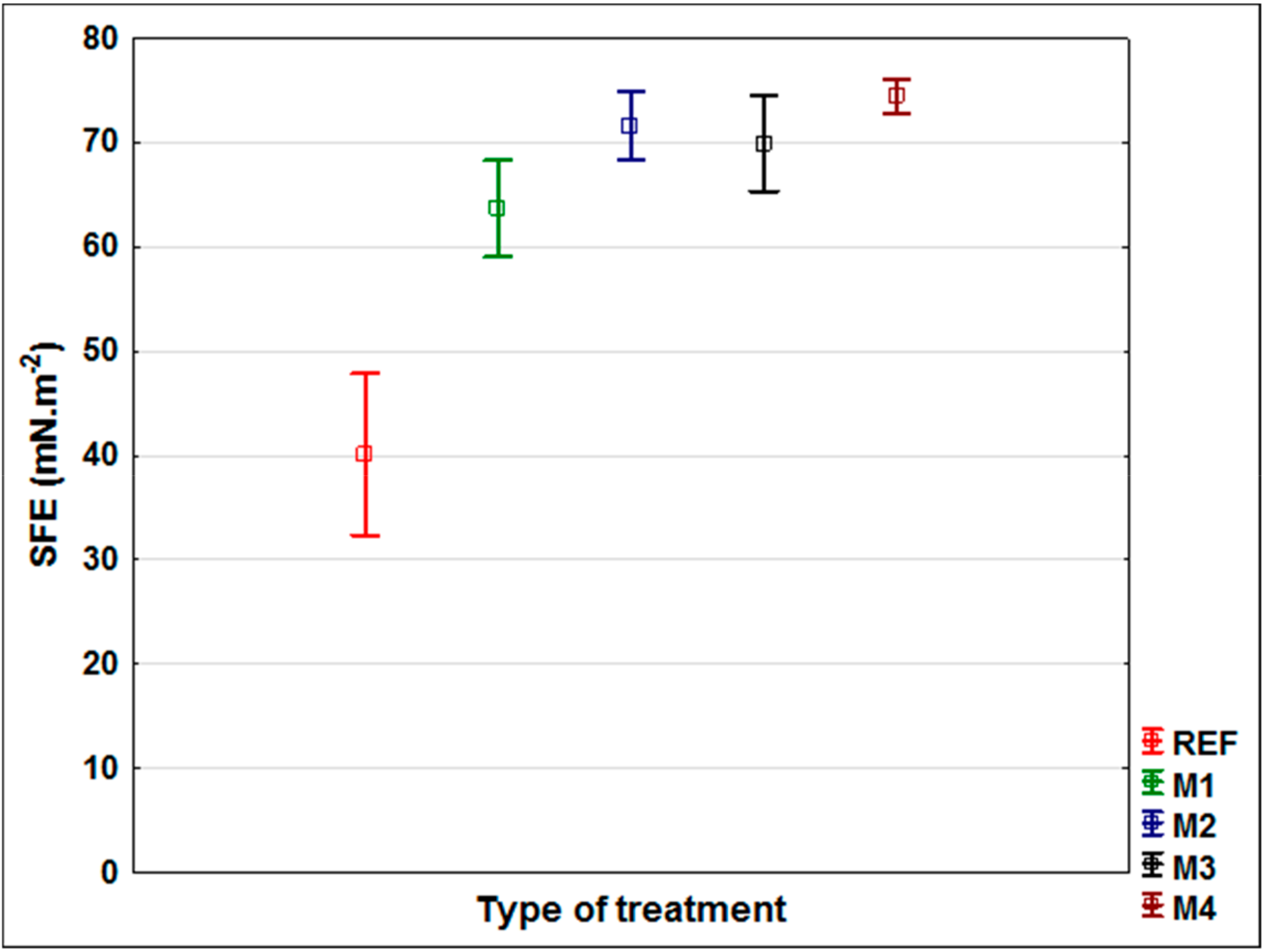

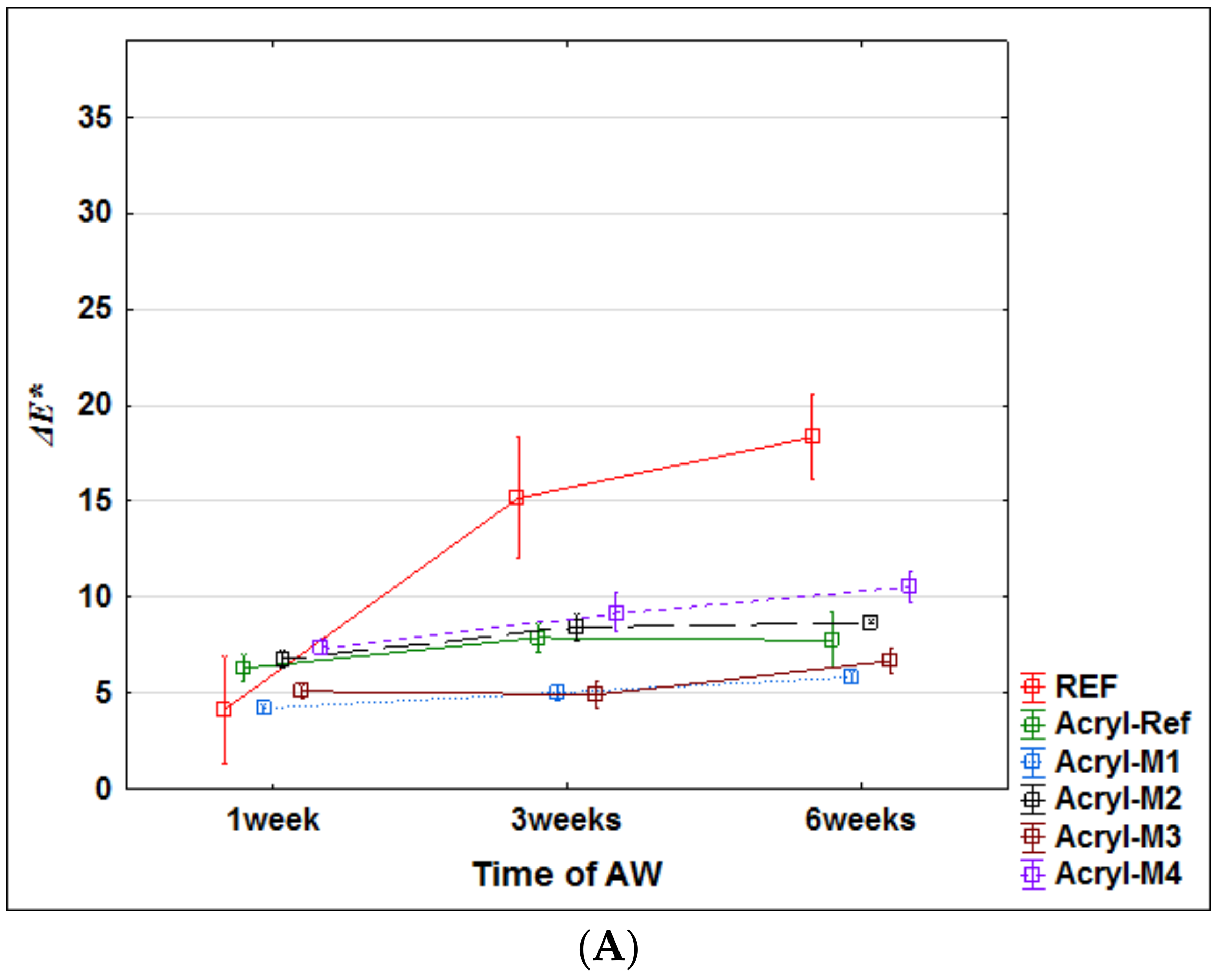
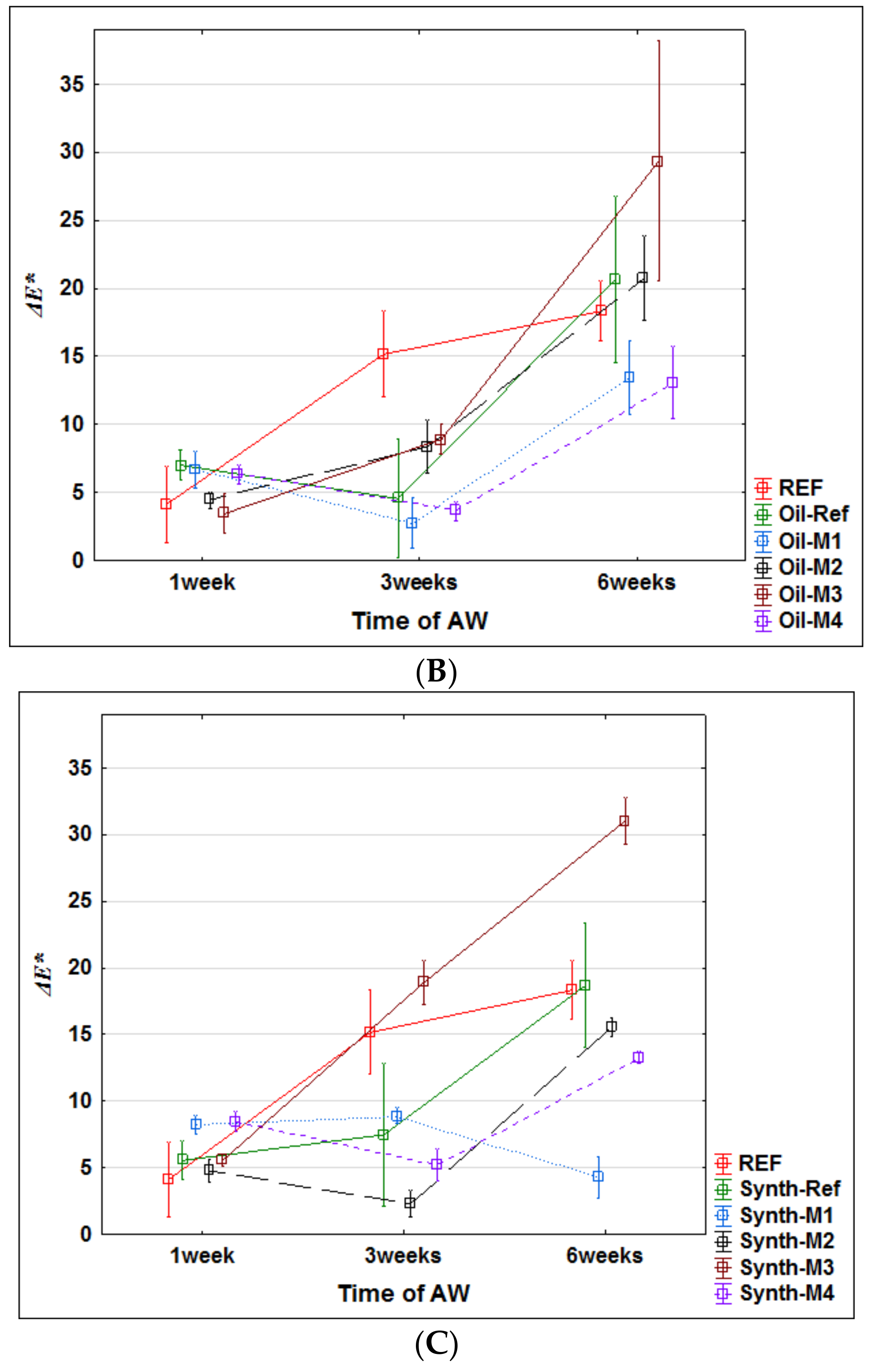
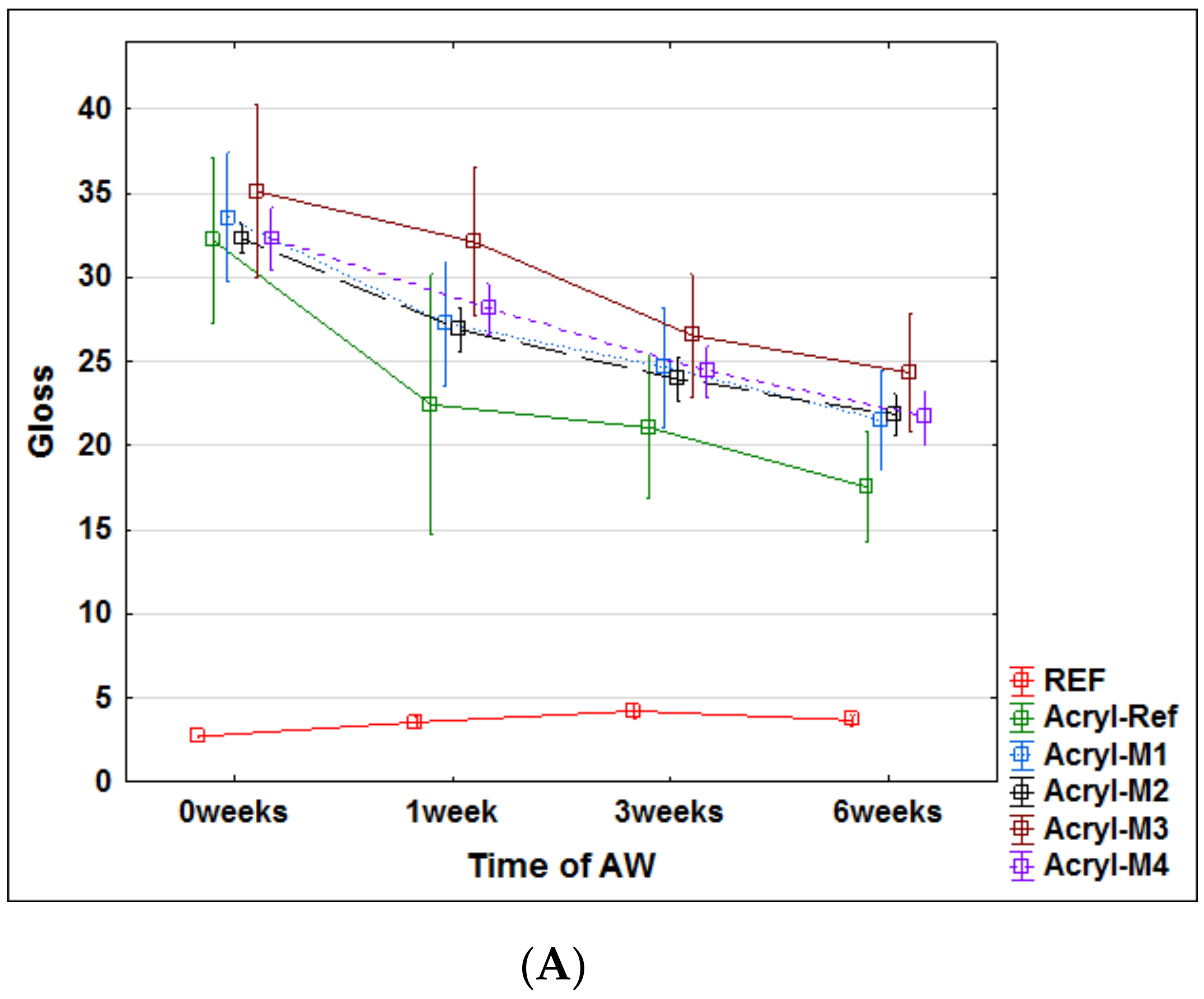
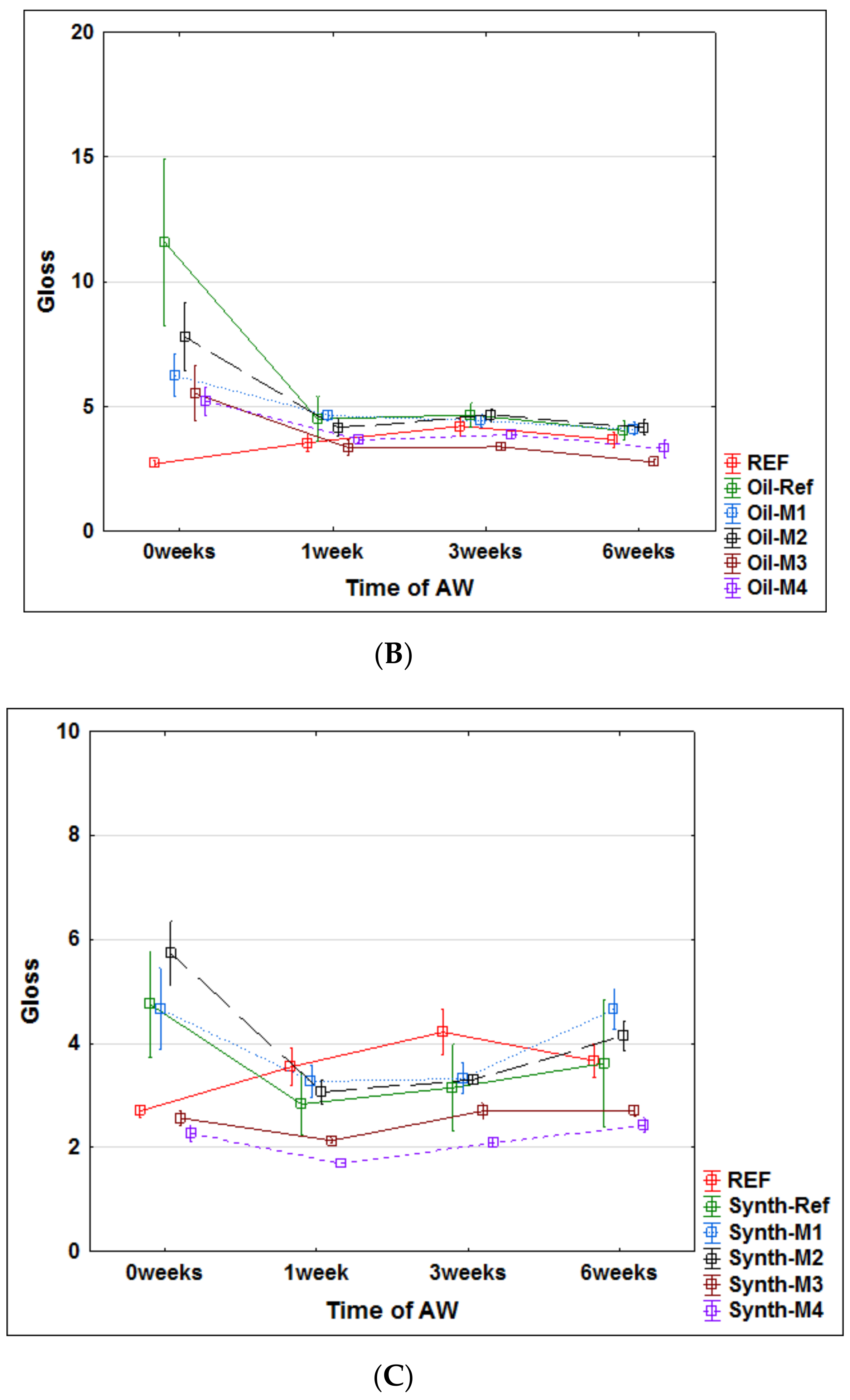
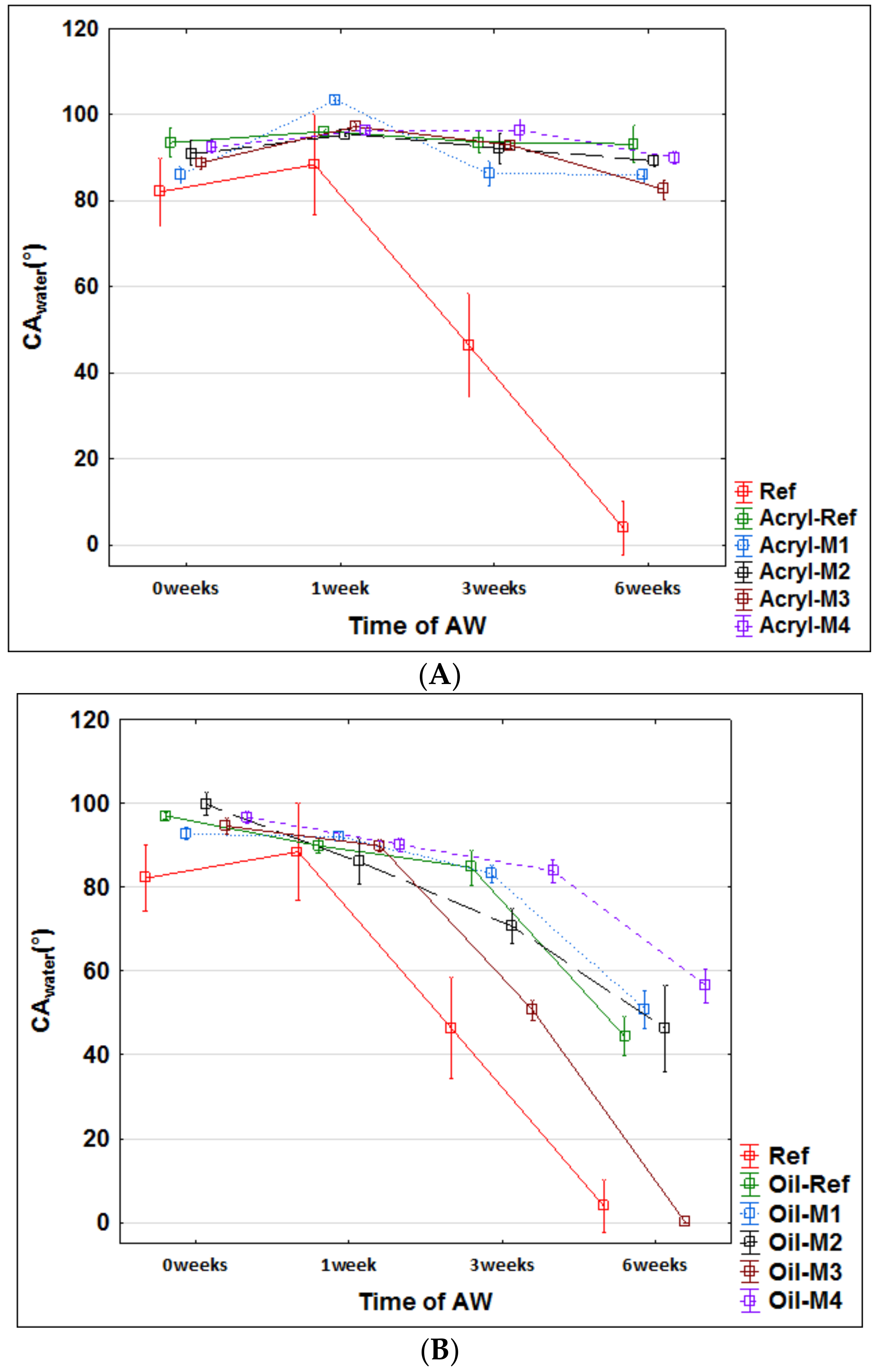
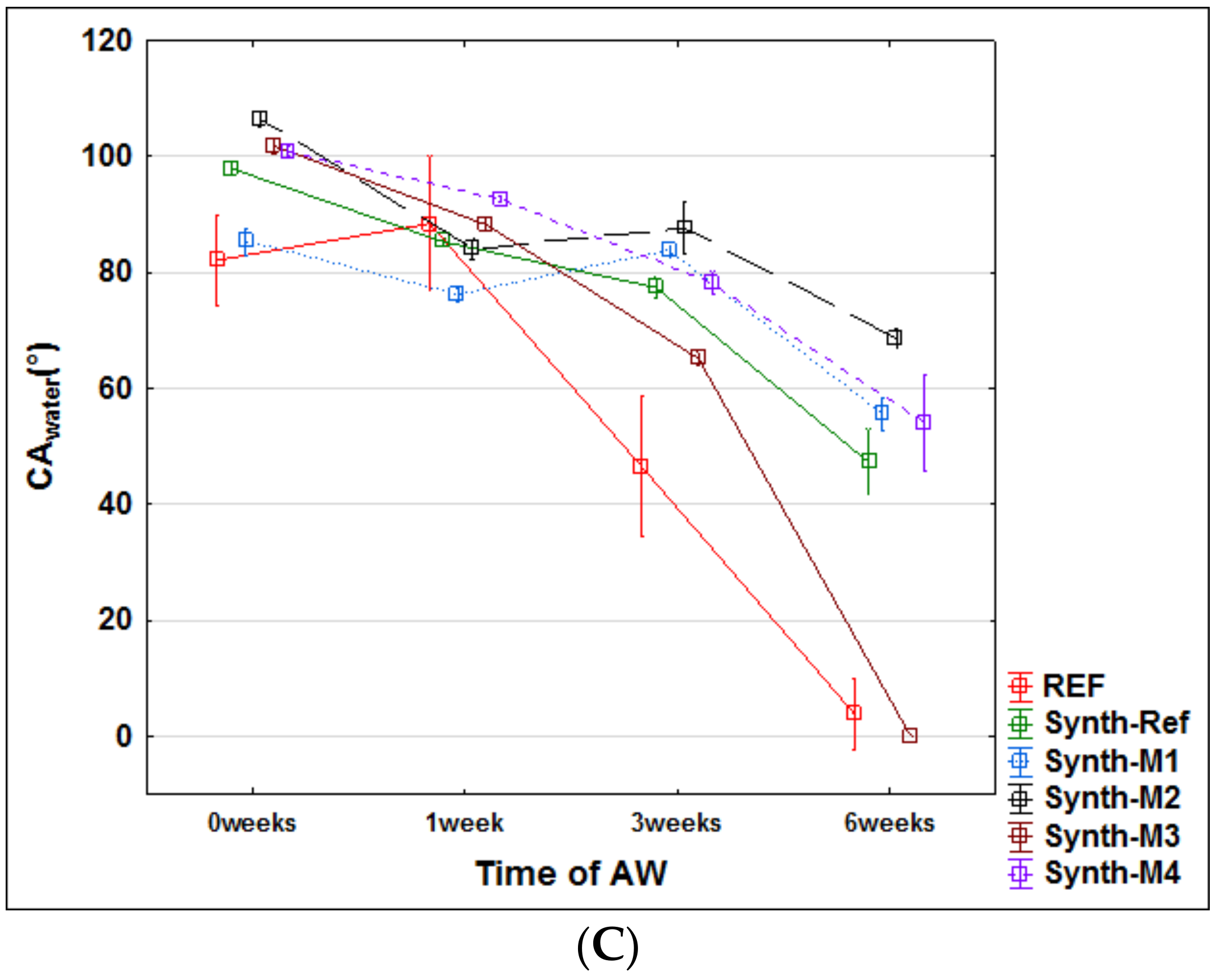

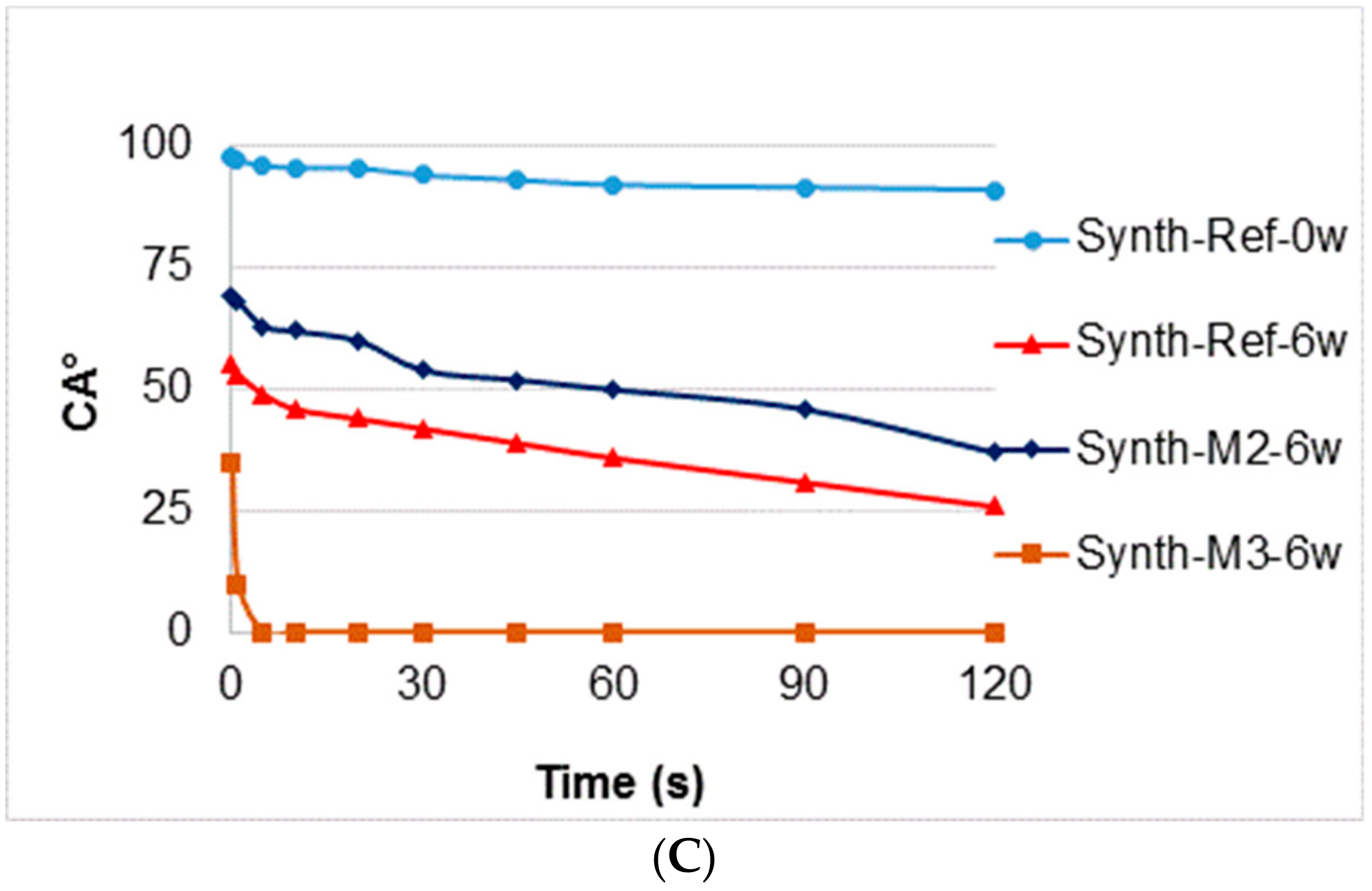
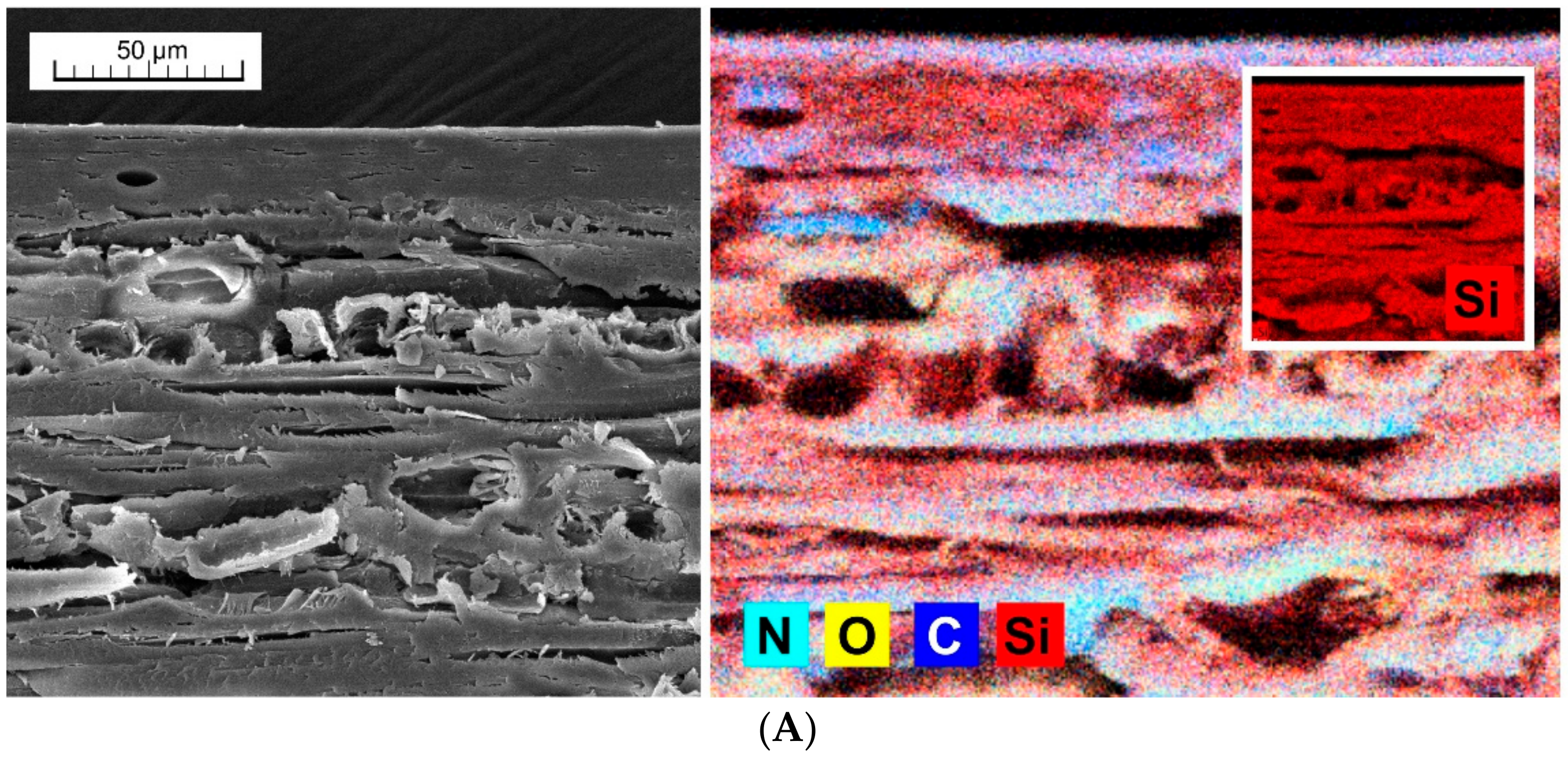
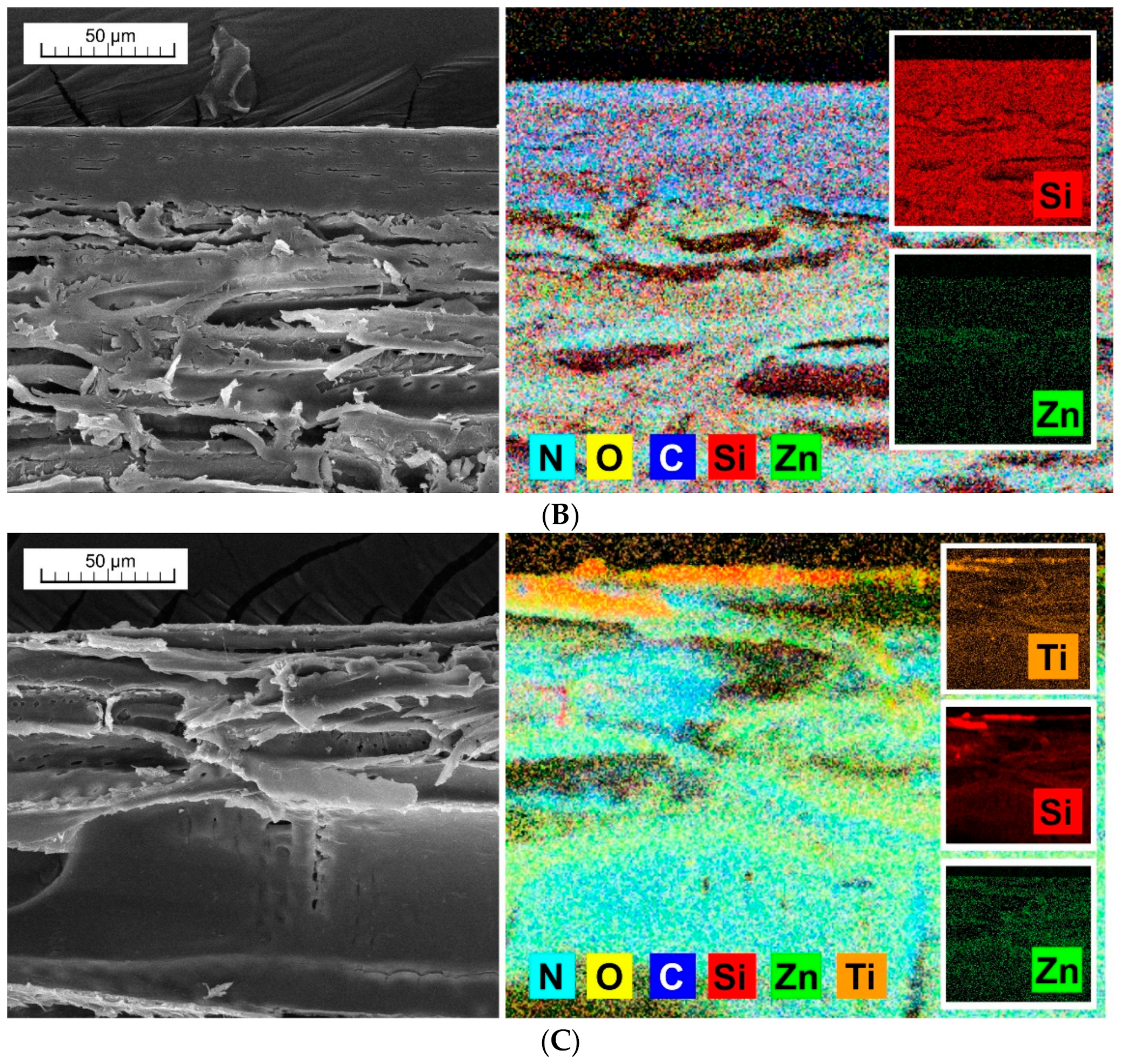
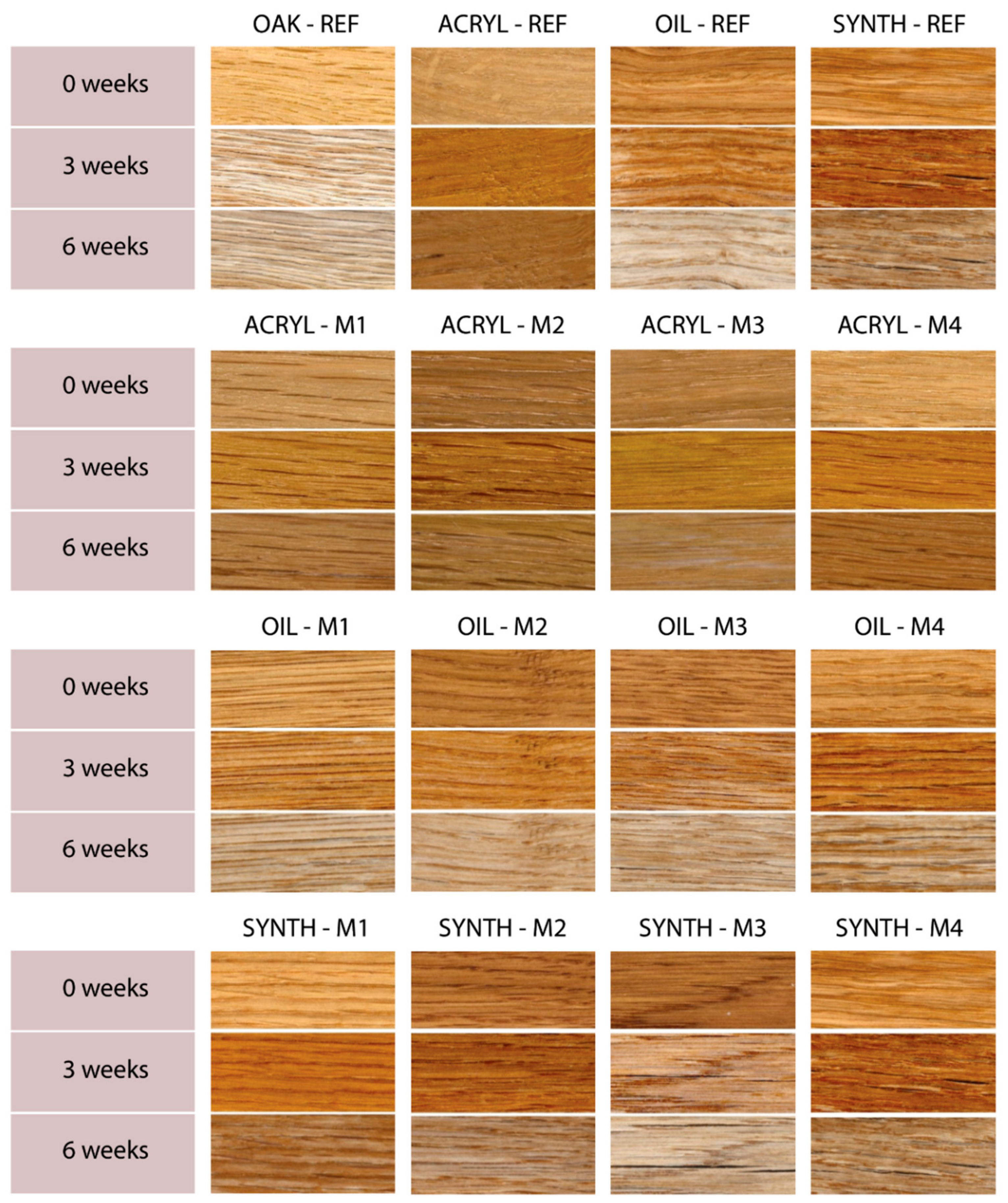
| Type of Surface Modification | Chemical Composition |
|---|---|
| Ref | Native Oak without modification |
| M1 | UV light-stabilizer (commercial product): 2-(2-hydroxyphenyl)-benzotriazoles with HALS (bis(1,2,2,6,6-pentamethyl-4-piperidyl) sebacate & methyl 1,2,2,6,6-pentamethyl-4-piperidyl sebacate); all in 3% water solution |
| M2 | UV light-stabilizer 2-(2-hydroxyphenyl)-benzotriazoles with HALS (M1) and nanoparticles of ZnO (25 nm)—weight ratio of UV stabilizers and nanoparticles in composition 1:1; all in 3% water dispersion concentration |
| M3 | UV light-stabilizer 2-(2-hydroxyphenyl)-benzotriazoles with HALS (M1) and mixture of ZnO:TiO2 nanoparticles (in a 1:1 weight ratio); ZnO (25 nm) and TIO2 (6 nm) nanoparticles—weight ratio of UV stabilizers and nanoparticles in composition 1:1; all in 3% water dispersion concentration |
| M4 | UV light-stabilizing penetration layer (commercial product) based on synthetic resins, organic UV light stabilizers, and IPBC fungicide |
| Type of Coating | Specification of Composition |
|---|---|
| REF | native oak wood without modification and without coating system |
| Acryl | Acrylic thick layer exterior coating: Acrylate thick-layer water-solved glaze with fungicides (5-chlor-2-methylisothiazol-3(2H)-on) and UV-stabilizers |
| Oil | Oil-based film forming exterior coating: Transparent oil-based coating containing dis-aromatized white spirit, natural vegetable oils, 3-iodo-2-propynyl N-butylcarbamate (IPBC) as fungicide, UV-stabilizers |
| Synth | Synthetic thin layer exterior coating: mixture of synthetic resins and oils in organic solvents with additives (BIT as fungicide 0.5%) and butanonoxime (0.5%) |
| Color Coordinate | REF | Acryl | Oil | Synth | ||||||||||||
|---|---|---|---|---|---|---|---|---|---|---|---|---|---|---|---|---|
| Ref | M1 | M2 | M3 | M4 | Ref | M1 | M2 | M3 | M4 | Ref | M1 | M2 | M3 | M4 | ||
| L* | 66.4 | 60.1 | 58.2 | 52.0 | 55.7 | 64.7 | 59.0 | 58.2 | 50.2 | 50.4 | 56.7 | 49.1 | 62.0 | 50.3 | 47.7 | 56.8 |
| a* | 7.2 | 7.8 | 7.1 | 8.6 | 8.5 | 7.7 | 10.8 | 9.1 | 11.9 | 12.8 | 9.9 | 11.4 | 10.1 | 12.8 | 13.6 | 11.8 |
| b* | 19.7 | 21.4 | 20.5 | 21.1 | 23.0 | 23.9 | 26.5 | 25.9 | 25.9 | 27.6 | 26.3 | 24.1 | 28.4 | 25.1 | 26.6 | 28.6 |
| Weathering in UV-Chamber: One Cycle = 1 Week (168 h) | Functions | ||
|---|---|---|---|
| 1st step | 24 h | Temperature 45 ± 3 °C, Water-Spray (off), UV (off) | |
| 2nd step | A | 2.5 h | Temperature 65 ± 3 °C, Water-Spray (off), UV Irradiance 1.10 W·m−2 at 340 nm |
| B | 0.5 h | Temperature 20 ± 1 °C, Water-Spray (on), UV (off) | |
| A + B | 3 h | ||
| Sub-cycle (A + B): 48 sub-cycles × 3-h of one, i.e., together 144 h | |||
© 2019 by the authors. Licensee MDPI, Basel, Switzerland. This article is an open access article distributed under the terms and conditions of the Creative Commons Attribution (CC BY) license (http://creativecommons.org/licenses/by/4.0/).
Share and Cite
Pánek, M.; Hýsek, Š.; Dvořák, O.; Zeidler, A.; Oberhofnerová, E.; Šimůnková, K.; Šedivka, P. Durability of the Exterior Transparent Coatings on Nano-Photostabilized English Oak Wood and Possibility of Its Prediction before Artificial Accelerated Weathering. Nanomaterials 2019, 9, 1568. https://doi.org/10.3390/nano9111568
Pánek M, Hýsek Š, Dvořák O, Zeidler A, Oberhofnerová E, Šimůnková K, Šedivka P. Durability of the Exterior Transparent Coatings on Nano-Photostabilized English Oak Wood and Possibility of Its Prediction before Artificial Accelerated Weathering. Nanomaterials. 2019; 9(11):1568. https://doi.org/10.3390/nano9111568
Chicago/Turabian StylePánek, Miloš, Štěpán Hýsek, Ondřej Dvořák, Aleš Zeidler, Eliška Oberhofnerová, Kristýna Šimůnková, and Přemysl Šedivka. 2019. "Durability of the Exterior Transparent Coatings on Nano-Photostabilized English Oak Wood and Possibility of Its Prediction before Artificial Accelerated Weathering" Nanomaterials 9, no. 11: 1568. https://doi.org/10.3390/nano9111568






